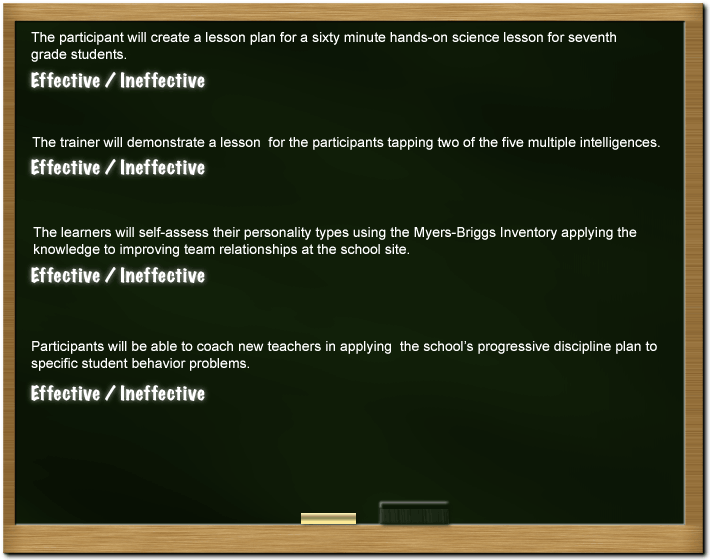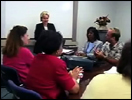Criteria for Specific Objectives
 Specific
objectives are designed to answer questions like: What will people be
able to know, do or create at their job site after the end of the adult
learning event?
Specific
objectives are designed to answer questions like: What will people be
able to know, do or create at their job site after the end of the adult
learning event?
![]() Think about
the design project you are developing for this course. What has been pinpointed
in the analysis phase of the needs assessment that will lead you to formulating
the specific objectives?
Think about
the design project you are developing for this course. What has been pinpointed
in the analysis phase of the needs assessment that will lead you to formulating
the specific objectives?
Listen to the reflection by the designer of the Upward Bound Leadership Training on the needs assessment data she gathered.

Based on a further analysis of the needs assessment results, the specific objectives were developed for the Upward Bound Leadership Training Program. Click on review to see examples of specific objectives for the program.
![]() Upward
Bound Leadership Team Training
Upward
Bound Leadership Team Training
DEFINITION
|
 Writing
the specific objectives is one of the more challenging parts of the design
process. The objectives are written so that the impact of the learning
can be measured.
Writing
the specific objectives is one of the more challenging parts of the design
process. The objectives are written so that the impact of the learning
can be measured.
Click on each to see a definition and example of a specific objective for that area.
Knowledge
Attitude
Skills
Aspirations
Behaviors
All specific objectives for effective staff development should meet the SMART Criteria.
Specific-each objective has a single key result
Measurable-each objective relates to behavior that can be measured
Attainable-each objective is realistic in terms of the available resources
Relevant-each objective is central to district or job site goals; and makes a difference in job performance or student achievement
Timely-each objective should be able to be accomplished within the time frame established for the staff development event
Directions
Read each specific learning objective and analyze the objective using
the following criteria:
- Does the objective contain the area: KASAB?
- Is the objective written in terms of learner performance?
- Is the expected performance change at the job site stated?
If you can answer yes to each of the three criteria, select effective
If you answer no to any one of the three questions, select ineffective.

If you were able to answer correctly, you are well on your way to learning how to structure specific objectives that meet the three criteria. If you were not able to answer correctly, scroll back up to review the definitions and examples of objectives in the Knowledge, Attitude, Skill, Aspiration and Behavior areas.
![]() Think about
the design you are preparing for this course. Staff development activities
are created to lead to change in behavior and results on the job. What
comes to mind as you reflect on the gaps in actual and desired performance
surfaced through your needs assessment data?
Think about
the design you are preparing for this course. Staff development activities
are created to lead to change in behavior and results on the job. What
comes to mind as you reflect on the gaps in actual and desired performance
surfaced through your needs assessment data?
![]() Create
a word document or make some notes with pen and paper to begin to brainstorm
possible actions that would overcome these gaps in performance that the
staff development is being created to change. Don’t worry about
the verbs yet. You will use these brainstormed ideas to create your objectives
in the next section of this course.
Create
a word document or make some notes with pen and paper to begin to brainstorm
possible actions that would overcome these gaps in performance that the
staff development is being created to change. Don’t worry about
the verbs yet. You will use these brainstormed ideas to create your objectives
in the next section of this course.
For example, in the Upward Bound team training a gap was effective meetings. Another performance gap was instructional improvement plans.
Bloom's Taxonomy
When writing specific objectives, you may refer to the suggestions of the Broward County HRD Department for verbs related to each of the Knowledge, Attitude, Skill, Aspiration, and Behavior areas. You may print these lists of suggested verbs for use in your writing of specific objectives for your adult learning activity.
![]()
Knowledge | PDF, Attitude | PDF, Skill | PDF, Aspiration | PDF, Behavior | PDF
The Bloom’s Taxonomy (PDF) can also be useful in developing adult learning experiences. Bloom’s taxonomy (PDF) provides the designer with another way to look at specific objectives at the:
- Knowledge,
- Comprehension,
- Application,
- Analysis,
- Synthesis and
- Evaluation levels.
 Adult learners
often have to have mastered content at knowledge and comprehension levels
before moving to the application, analysis, synthesis and evaluation levels.
Adult learners
often have to have mastered content at knowledge and comprehension levels
before moving to the application, analysis, synthesis and evaluation levels.
Review the Bloom’s Taxonomy levels and the related verbs the designer can use in creating specific objectives. Later in this course we will relate each of these levels to activities and strategies the designer can use.
Writing Objectives Template
To assure your knowledge and comprehension of the Broward County HRD Department’s definition of specific objectives, fill in the missing words below in the definition.
![]()
Specific Learning Objectives are that describe in terms of knowledge, attitude, skill, aspiration, and behavior performance, rather than trainer performance or instructional procedure expected performance at the job site. |
|||
| View Expert Definition | |||
If you were able to get the correct answers, let’s proceed with writing a sample specific objective. If you were not, go back and review the definition of specific objectives and some examples.
In the example of the Upward Bound Leadership Training one of the performance gaps was ineffective meetings. The designer determined that this would be a skill area objective. She selected the verb "to practice".
Participants will practice the roles needed to help the leadership team function effectively at the school site.
Now you try it.
First, look at your notes on gaps identified through the needs assessment.
Second, select verbs to best describe the actions you want the learner
to be able to take.
Third, create the specific objective in terms of what the learner will
do.
![]() Mod 2 A: Select a performance gap that can be filled
by new knowledge, skill or behavior change and develop two or three specific
objectives for your course in one of these three areas. For each objective
follow the template, responding to the questions and developing your
objectives. You may fax or U.S. mail or Pony Mail it to
your facilitator. (PDF)
Mod 2 A: Select a performance gap that can be filled
by new knowledge, skill or behavior change and develop two or three specific
objectives for your course in one of these three areas. For each objective
follow the template, responding to the questions and developing your
objectives. You may fax or U.S. mail or Pony Mail it to
your facilitator. (PDF)
In the first study group we will present and critique one another’s specific objectives. You have completed one of the most difficult parts of designing staff development. Once we know what we want the learners to know and be able to do and how you will evaluate it, the fun and creative part of designing begins.
